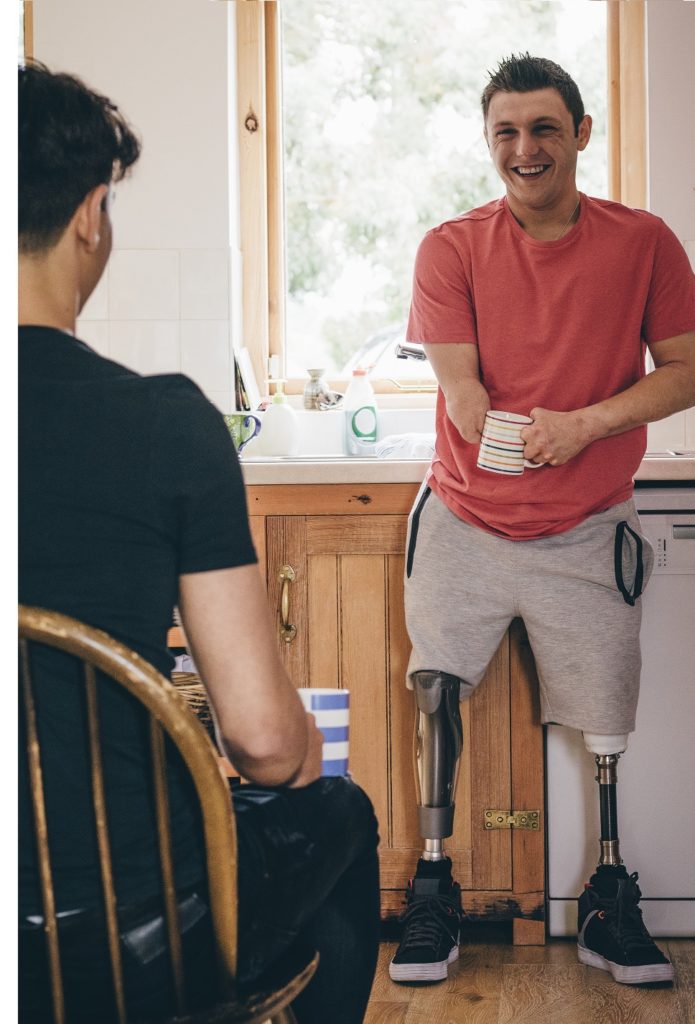How will amputees sustain community in the era of social distancing?

For several decades, members of Amputees in Motion (AIM) have made the rounds at San Diego hospitals to support new amputees.
“When they see us walk in, their faces light up,” says Gary Elhard, AIM’s secretary/treasurer. “So does their spouse, their relatives, friends, and whoever else is in the room with them. Just to see that we’re walking perks them up. Then they find out we drove ourselves to the hospital. They ask a lot of questions, and they often want to see how our prosthetic works. It gives them a sense of security that their lives will get back to normal.”
Those are incredibly powerful connections, Elhard says—but they’ve been broken for several weeks because of COVID-19. When the pandemic began to gain steam in California in early March, Elhard and AIM’s other officers decided to halt in-person visits to hospitals, where a single wayward germ could inflict devastating consequences. They also called off the organization’s monthly membership meeting, which would have taken place this Saturday.
Dozens of support groups around the country are making similar decisions, whether voluntarily or under force of law. As of Monday night, 15 states had issued stay-at-home orders that forbid residents from venturing out except for essential needs such as food, gas, or health care.
Amputee peer visits and support groups aren’t considered “essential” in a public health crisis, and understandably so. But they still play an indispensable role in the lives of many amputees.
Elhard sees it every month at AIM’s membership meeting. There’s usually a speaker on a subject like phantom pain, exercise, the latest prosthetic technology, or whatever. But the best thing about the evening is the camaraderie. Like everyone else, amputees enjoy getting together with members of their own tribe. It’s energizing and empowering.
That’s now lost for an unknown interval. So are the hospital visits, which are not only encouraging for postsurgical amputees but also deeply rewarding for AIM’s members.
“When you walk out of that hospital room,” he says, “you’re on an incredible high. It’s hard to describe how good it feels to be able to give back.”
Alternative ways for amputees to stay connected?
With in-person visits no longer possible, AIM members have continued reaching out to new amputees. They’re just doing so remotely.
“We’re calling people in the hospital or at home after they’re discharged,” Elhard explains. “We can still talk to them about our experiences, and they can still ask questions.” But phone interactions don’t produce the powerful sense of connection that face-to-face meetings do, says Elhard. And telling isn’t the same as showing.
“We want to reassure people that they’re going to overcome all the challenges that they face,” he says. “But when you’re not right in front of them—when they can’t see you or your prosthetic, when they have to just conjure it in their minds—it doesn’t have the same impact.”
While digital platforms such as Zoom and Skype have helped schools, businesses and other organizations preserve a sense of community, Elhard doesn’t think they’re a viable option for AIM. Most of the group’s members are older, he says, and many either don’t own a computer or have limited ability to use one—”they’re face-to-face communicators,” as Elhard puts it. So broadcasting the monthly membership meeting over a webinar platform such as LiveStorm or ClickMeeting—or even just streaming it live over Facebook—wouldn’t allow most of AIM’s members to participate.
Where does that leave AIM? How will it sustain connections if the stay-at-home orders extend into April or May?
“That’s something our director, our president, and I are discussing,” says Elhard. “We have a very powerful speaker lined up for our April meeting, a doctor who’s conducting research about phantom pain. Our May speaker is a Pilates instructor who is going to do a demonstration of Pilates and physical fitness for amputees. We’ve spent the last week or 10 days trying to decide what we should do, and what we can do.”
If no other solution presents itself, AIM’s leaders intend to call each of the 300+ members individually. The three officers have already divided up the membership list, just in case.
“It’s not efficient,” Elhard says. “But we need to know that our members are doing ok. And they need to know we’re still here.”